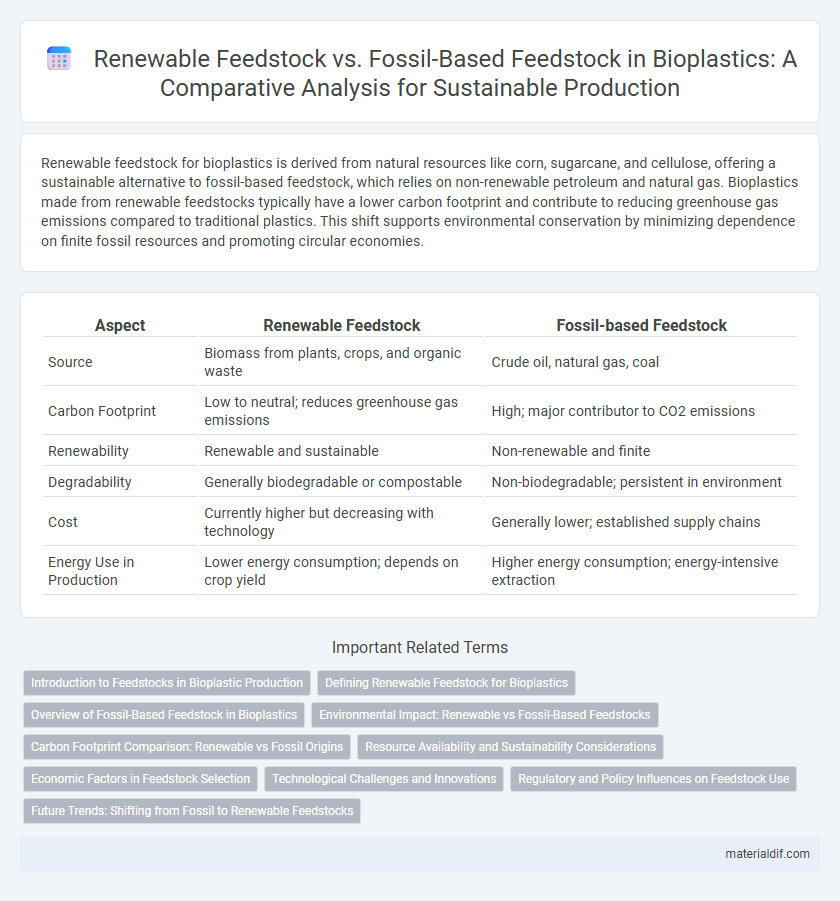Renewable feedstock for bioplastics is derived from natural resources like corn, sugarcane, and cellulose, offering a sustainable alternative to fossil-based feedstock, which relies on non-renewable petroleum and natural gas. Bioplastics made from renewable feedstocks typically have a lower carbon footprint and contribute to reducing greenhouse gas emissions compared to traditional plastics. This shift supports environmental conservation by minimizing dependence on finite fossil resources and promoting circular economies.
Table of Comparison
| Aspect | Renewable Feedstock | Fossil-based Feedstock |
|---|---|---|
| Source | Biomass from plants, crops, and organic waste | Crude oil, natural gas, coal |
| Carbon Footprint | Low to neutral; reduces greenhouse gas emissions | High; major contributor to CO2 emissions |
| Renewability | Renewable and sustainable | Non-renewable and finite |
| Degradability | Generally biodegradable or compostable | Non-biodegradable; persistent in environment |
| Cost | Currently higher but decreasing with technology | Generally lower; established supply chains |
| Energy Use in Production | Lower energy consumption; depends on crop yield | Higher energy consumption; energy-intensive extraction |
Introduction to Feedstocks in Bioplastic Production
Renewable feedstocks for bioplastic production primarily include plant-based materials such as corn, sugarcane, and cellulose, which contribute to sustainability by reducing carbon emissions and reliance on finite resources. Fossil-based feedstocks, derived from petroleum and natural gas, dominate traditional plastic manufacturing but pose environmental challenges due to their non-renewable nature and higher greenhouse gas output. Transitioning to renewable feedstocks enables the development of biodegradable and compostable bioplastics, supporting a circular economy and reducing plastic pollution.
Defining Renewable Feedstock for Bioplastics
Renewable feedstock for bioplastics primarily includes biomass sources such as starch, cellulose, sugars, and vegetable oils derived from plants like corn, sugarcane, and soybeans. These materials are biologically sourced and capable of regenerating within a short time frame, contrasting with fossil-based feedstock, which relies on non-renewable petroleum or natural gas. Defining renewable feedstock emphasizes its origin from sustainable agricultural practices and carbon-neutral lifecycle, reducing reliance on finite fossil resources and lowering overall environmental impact.
Overview of Fossil-Based Feedstock in Bioplastics
Fossil-based feedstock in bioplastics primarily consists of petrochemicals derived from crude oil and natural gas, serving as the raw material for conventional plastics like polyethylene and polypropylene. This feedstock is characterized by high carbon intensity and non-renewability, contributing to environmental concerns such as greenhouse gas emissions and resource depletion. Despite these drawbacks, fossil-based feedstock remains dominant due to established supply chains, cost-effectiveness, and well-developed manufacturing technologies in the plastics industry.
Environmental Impact: Renewable vs Fossil-Based Feedstocks
Renewable feedstocks for bioplastics, derived from biomass such as corn, sugarcane, or cellulose, significantly reduce carbon emissions by capturing atmospheric CO2 during plant growth, contrasting with fossil-based feedstocks that release stored carbon from ancient reserves, intensifying greenhouse gas accumulation. The cultivation and processing of renewable feedstocks can promote soil health and biodiversity when managed sustainably, whereas fossil feedstock extraction often disrupts ecosystems and contributes to pollution and resource depletion. Lifecycle assessments consistently show that bioplastics from renewable sources have a lower overall environmental footprint, particularly in terms of carbon emissions, energy consumption, and potential for biodegradability, compared to conventional plastics derived from petrochemicals.
Carbon Footprint Comparison: Renewable vs Fossil Origins
Renewable feedstock for bioplastics significantly lowers carbon footprint by capturing atmospheric CO2 during biomass growth, contrasting fossil-based feedstock that releases long-stored carbon upon extraction and processing. Life cycle assessments reveal bioplastics derived from renewable sources often achieve up to 70% reduction in greenhouse gas emissions compared to conventional petrochemical plastics. This carbon advantage enhances sustainable production pathways and aligns with global decarbonization goals.
Resource Availability and Sustainability Considerations
Renewable feedstocks for bioplastics, such as corn, sugarcane, and cellulose, offer a sustainable alternative by utilizing abundant biological materials that replenish naturally, reducing dependency on finite fossil resources. Fossil-based feedstocks rely on petroleum and natural gas, which are limited and contribute significantly to greenhouse gas emissions and environmental degradation. The use of renewable feedstocks supports lower carbon footprints and enhanced resource availability, aligning with circular economy principles and sustainable development goals.
Economic Factors in Feedstock Selection
Renewable feedstocks for bioplastic production often involve crop-derived materials like corn and sugarcane, which can be influenced by agricultural yields and seasonal fluctuations, impacting cost stability. Fossil-based feedstocks benefit from established petrochemical infrastructure, offering consistent supply and pricing, but face volatility linked to oil market dynamics and geopolitical factors. Economic considerations include feedstock availability, processing costs, and potential subsidies or carbon pricing mechanisms that affect overall competitiveness in bioplastic manufacturing.
Technological Challenges and Innovations
Renewable feedstock for bioplastics faces technological challenges such as efficient biomass conversion, feedstock variability, and scalability of production processes, requiring innovations like advanced enzymatic hydrolysis and synthetic biology to enhance yield and consistency. Fossil-based feedstock benefits from established infrastructure but struggles with environmental sustainability, prompting innovations in catalyst design and carbon capture to reduce emissions. Integrating renewable feedstock technologies with petrochemical advancements drives the development of hybrid bioplastics, improving performance while minimizing environmental impact.
Regulatory and Policy Influences on Feedstock Use
Renewable feedstock in bioplastics benefits from increasing regulatory incentives such as subsidies, tax credits, and mandates favoring sustainable materials to reduce carbon emissions and dependence on fossil fuels. Fossil-based feedstock faces stricter environmental regulations, including carbon taxes and stricter waste management policies, driving manufacturers toward renewable alternatives. Policies like the European Union's Green Deal and the US BioPreferred Program specifically promote renewable feedstocks by setting targets for biobased content in plastic products.
Future Trends: Shifting from Fossil to Renewable Feedstocks
Future trends in bioplastics reveal a significant shift from fossil-based feedstocks to renewable feedstocks such as corn starch, sugarcane, and algae. This transition supports reduced carbon emissions and enhances biodegradability, aligning with global sustainability goals. Innovations in feedstock efficiency and bioprocessing technologies continue to drive the scalability and cost-effectiveness of renewable bioplastic production.
Renewable feedstock vs Fossil-based feedstock Infographic

 materialdif.com
materialdif.com